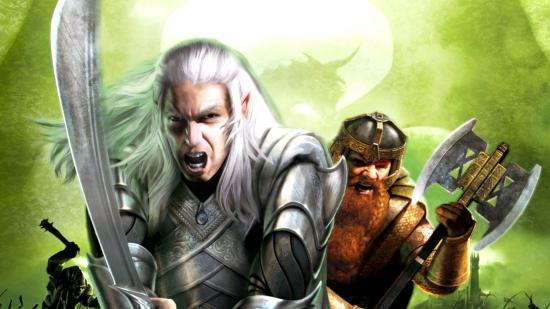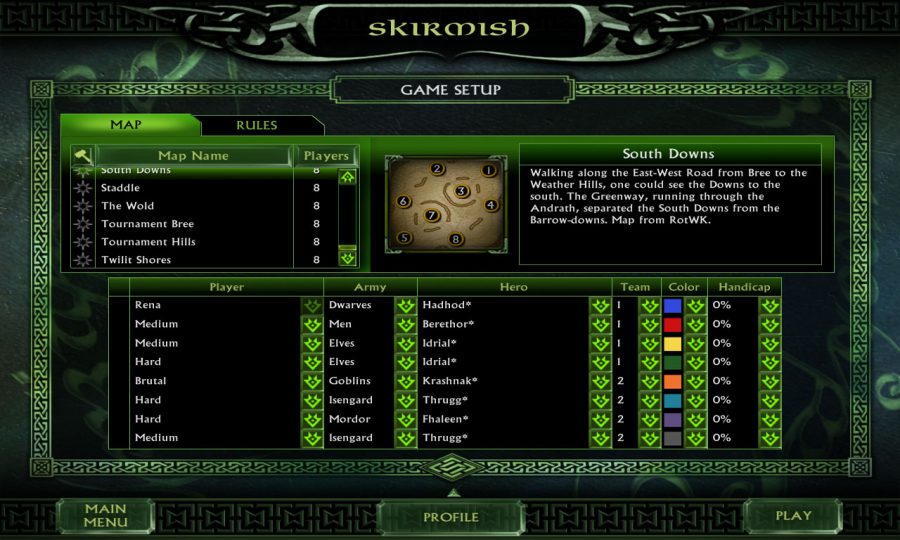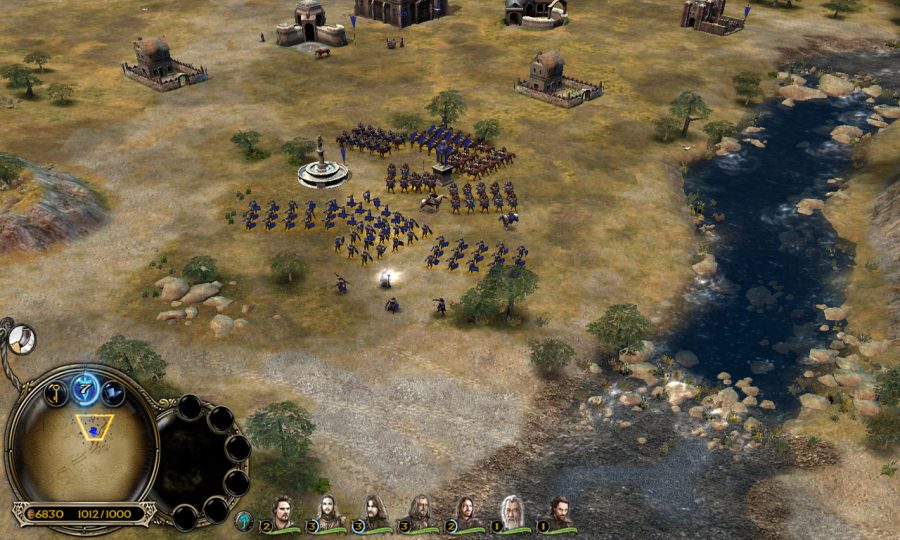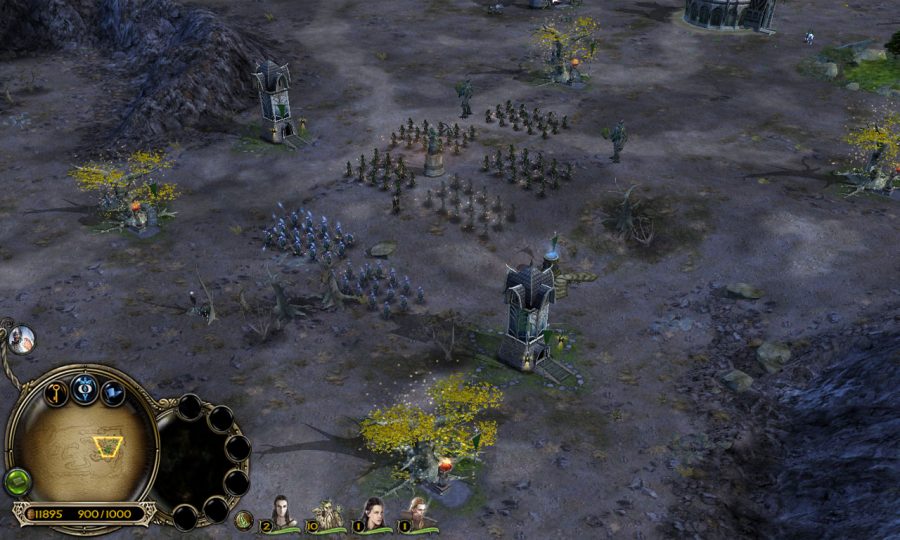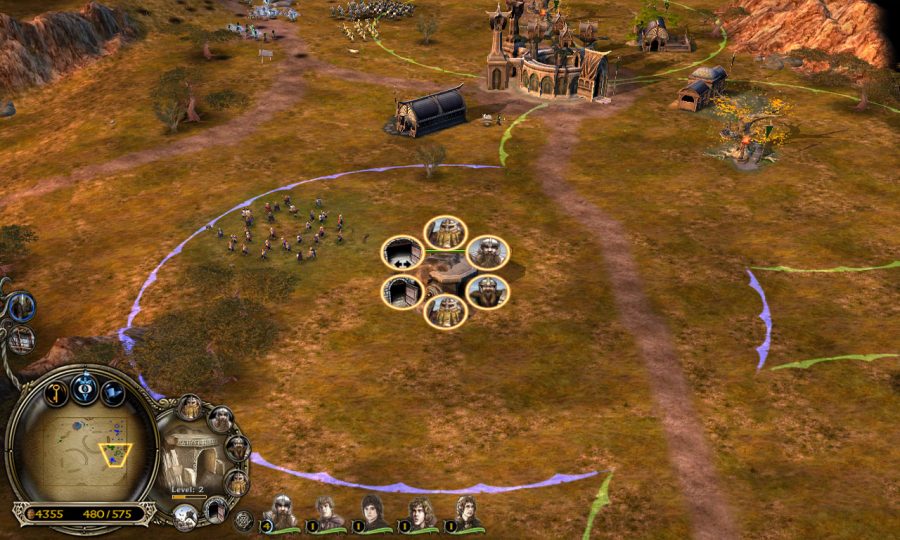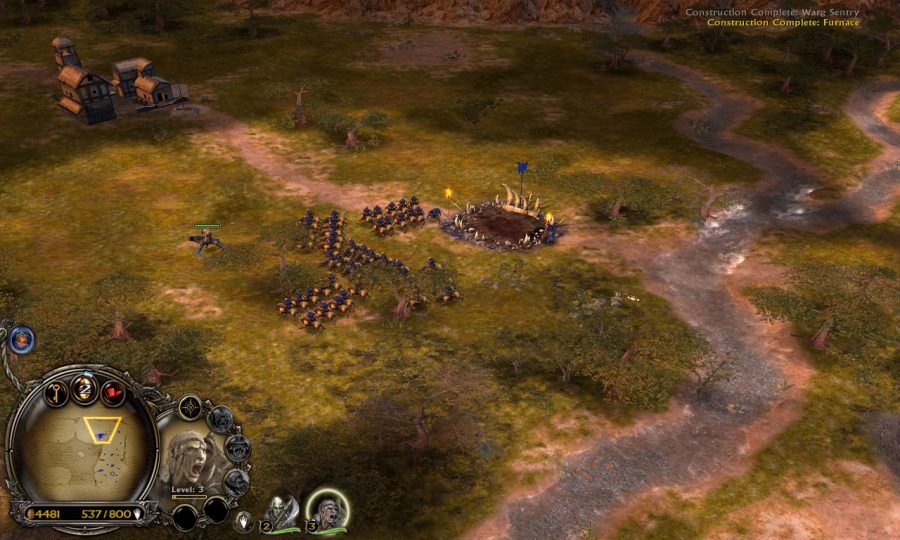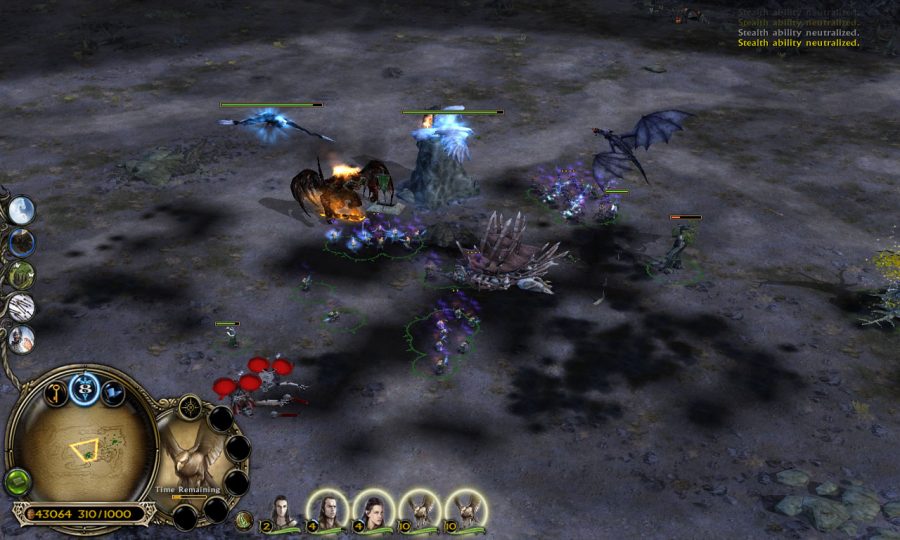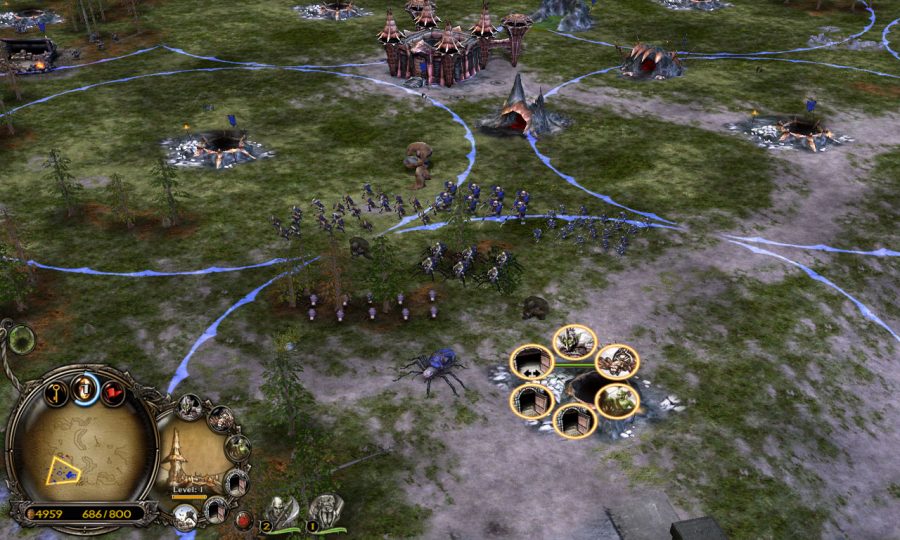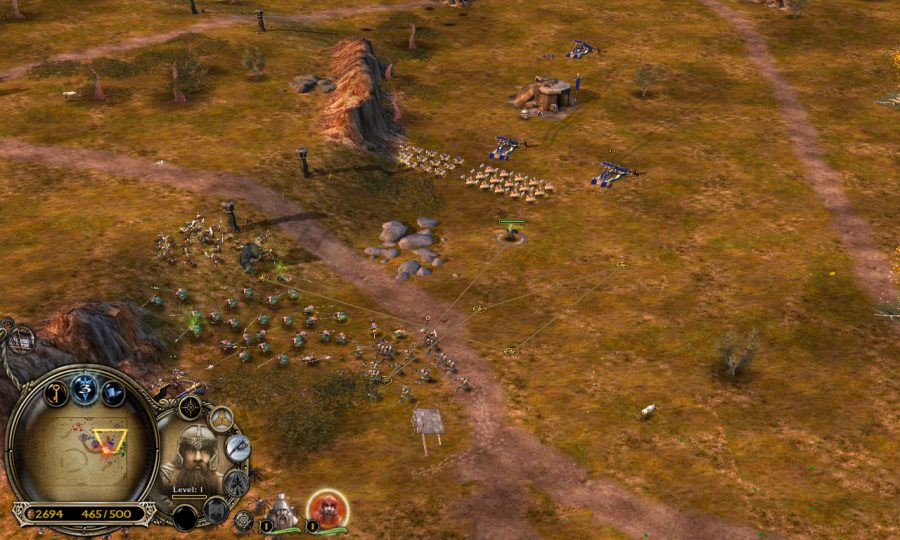Made and released by EA Games in February, 2006, Lord of the Rings: Battle For Middle-Earth II is the perfect game for those in love with the books or the films based on Tolkien’s literary work. I mean, who has never thought about being the commander of the human armies, leading them to take over Dul Guldur from the orcs (or, as the most likely scenario, lose badly against them – that fortress is a nightmare to play against)? Maybe even control the Uruk-hai and swarm over Gondor, facing and destroying elves, humans and dwarves alike?
In a game featuring six different armies, over 40 maps with up to eight players, all of that is possible.
Aside from the book and film references the game gives Lord of the Rings fans, it also allows strategy gamers to put their skills to the test. In this game, the planning starts before the match even begins with choosing a few different things: the map; the position you’ll place your fortress; and which faction you’re playing as. There is a distinct strategy to be used depending on your choices and they can greatly affect how your campaign goes.
Also, the way the armies, the characters, and maps have been depicted in Battle for Middle-Earth 2 will definitely make Tolkien fans feel nostalgic and excited to play more. Before going into each different faction and discussing them specifically, let’s go over a little bit about the general structure that each alignment has. Some of the strategies are quite similar and there’s no point in repeating ourselves.
The Factions: Light vs Dark
Much like in the books, Battle for Middle-Earth 2 is divided in two factions: the ‘light’ side, composed of the armies of men, elves and dwarves; and the ‘dark’ side, made of Isengard, Mordor and goblins. Breaking it down to core strategies: when using the light armies you should focus on making basic units and protecting them to buy you time as you save up to develop a stronger army; with the forces of darkness you want to take advantage of the huge units diversity they have and quickly build up your numbers.
A common and important strategy for the light factions are the healing and power boosting buildings. Those are particularly important at the beginning of the game when you’re trying to build up your armies but know that you’ll soon get attacked and want to lose as little of your units as possible. The Well building (for men) allows you to heal and restore some of your lost units, so it’s always good to have it on the location you see as your weak spot, to stop enemies from reaching your fortress. The other building is a hero’s statue; it grants attack and defence bonuses that’ll allow you to protect your weak units and start the game more effectively.
More like this: Here are the best RTS games on PC
For the dark forces, the important thing to note is that there are a lot of units that attack buildings, which means that the strategy is to focus on destroying enemy structures first, instead of focusing on troops. Also, keep in mind that although the diversity these factions have is an advantage, repeated troops gain bonuses for every other unit of the same kind when near each other, so it’s good to train more than one of each. The three sub-factions have Lumber Mills, which are buildings that allow you to harvest resources from any trees – which alludes to Saruman ordering orcs to cut down trees to feed Isengard’s furnaces. So, as soon as you can, build those as close to the biggest patch of wood available.
With that out of the way, let’s take a look at the particulars of each faction, what to do with them, and what fans should look forward to!
Men (Light)
Their resource buildings are quite weak; if you think about the books and films, you’ll remember that the farms are the first places that orcs and uruk-hai attack. Therefore, you want to protect them as much as you can: build them close to your armies and other constructions to make sure you don’t lose your abilities to gather resources – you’ll definitely need them.
The main strategy for the men are horses… all the horses, with hero Éomer to lead them. Rohirrim are a must when using this army, but you have to be very careful when controlling and using them. Make sure you have Gondor soldiers to destroy any enemy pikemen, so they don’t kill all your knights. The Rohirrim are really fast and strong, and with Éomer at the helm, you can easily flank them around enemy troops to take out your foes, just like he does in the films.
The heroes are, I believe, one of the most important things about this faction. Aside from there being a lot of them, they really are quite strong, and the first ones are not that expensive. I always start with Boromir, as he can really help you at the beginning of the game and is a cheap and powerful unit. As you go forward, of course, other heroes have special abilities that make them quite helpful for mass battles and distracting the enemies’ forces – such as Gandalf and Aragorn, both of which are very powerful units with a lot of special attacks and life points.
Elves (Light)
Elves need a lot of open terrain; their resource gathering buildings take a lot of space, so choosing the corner of a map or a cluttered one is often not a very good idea. However, you can’t just place them anywhere either as they have a special bonus: they are like watch towers. Contrary to other resource gathering buildings, the elven trees defend themselves with archers– for free! So even if you do build your trees a little away from your fortress, as long as you have a small force nearby, they’ll be able to withstand a direct attack. You want to keep them in a way that you create a path for your army, making sure that they are protecting each other. The elves on the resources trees are a reference to the woodland and Lothlórien elves, who used to scout and build watchtowers above ground in the forest to look out for intruders.
The strategy for elves is pretty straight forward. First, you don’t want to waste resources on basic archers; just build some fighters to protect yourself. Second, as soon as you can, upgrade your archery range to be able to acquire Mirkwood archers, and upgrade their weapons to fire arrows. That’s it. Build soldiers to protect them and towers to place them on, but always focus on the archers. Also, don’t bother building their stables; though fast, they are not as strong as the Rohirrim, and will end up being a waste of resources better spent elsewhere. Getting Ents might sound fun and they can be quite helpful, but only late into the game when you’re ready to do some structural damage to the enemy, since they are very, very slow and don’t have that much health.
Their heroes are not that impressive, but I’d still recommend having Haldir and Legolas to lead the archers, and Elrond when you have resources available for his special powers, but don’t be overly concerned if you don’t have enough command points for them.
Dwarves (Light)
The main strategy you have to use when playing as dwarves is the opposite of the other two: space out your resource buildings as much as you can. Why? Because, as a really brilliant reference to the books, they are all interconnected by tunnels. That means that you can transport up to 5 units from any mine to the other, no matter how far away they are, and it’s almost instantaneous. In his books, Tolkien often described the dwarven cities as enormous kingdoms spread all underground (or, in the Longbeard’s case, under a mountain), so this is especially fitting.
Another thing Tolkien’s dwarves are known for are their crafting abilities – which even rivalled that of the elves (something the latter would never admit). Such mastery is shown in the game by the Forge Works building. Since the dwarves have no riders, what they do have are catapults, battlewagons and demolishers, which, though not really shown in any of the books or films, are quite fitting with their culture and abilities. You really want to make use of them and focus on attacking the enemy buildings as much as possible to weaken them and then strike with soldiers (don’t bother with their archers).
It’s very sad to talk about the dwarven heroes, mainly because there are only really three. I mean, The Hobbit alone has 13 dwarves important to the plot, including a couple that are mentioned in Lord of the Rings as well, so this could easily have been better planned and executed. Still, of the ones that do exist, Gimli is by far the best one, and not only for his film lines; he is quite strong and quite quick. Also, I can’t stress enough how hilarious it is to hear Gimli mumbling around “Why must we always be running?” as you ask him to go from here to there.
Isengard (Dark)
Wargs are, hands down, the best thing about Isengard. They are fast, strong, and honestly? Just really cool. I’d definitely also recommend recruiting the warg leader, Sharku, to fight alongside your warg army since he makes them easier to control. Again, just like with the human army, it’s very important to build basic fighters so you don’t get all your wargs killed by pikemen right away. I often leave them in the rear, sending my fighters first and, once they’re engaged in combat, taking the wargs to destroy everyone else.
Another very interesting and rewarding strategy for Isengard is to build the Warg Sentry. They are relatively cheap buildings that allow you to protect quite a big area without having to worry about using your main army to deal with scouts or stragglers. You kill the main bulk of the enemy’s forces and leave the stragglers for the Sentry to finish off. Since you won’t have healing or or boosts from other buildings, this will go a long way in helping you keep a sizeable army at the beginning of the game.
For heroes, you have Sharku, Lurtz (the Uruk-Hai commander), Grimma, and Saruman – and let me tell you, hearing Christopher Lee’s voice booming on your ears is reason enough to pick this army.
Mordor (Dark)
True to the books and films, when you decide to use Mordor, the main focus is to create as many attacking units as possible. Since building resource structures (called the Murder House for this army) too far away from you can get you in trouble fast, using the Lumber Mill is the way to go. Make sure you pick a place on the map where you don’t have a lot of open spaces. Your army is slow – you want to make sure you’re well protected and contained.
Aside from the basic buildings and the lumber mills, all other buildings available are about stacking up your numbers with a big mix of different kinds of units: you have trolls, goblins, easterlings, mûmakils, and the corsairs of Umbar; thus, you want to use that to your advantage. Mûmakils are very hard to kill; they have a lot of health and are really strong against buildings, archers and even swordsmen. What I usually do is build up a lot of pikemen to travel around them for protection and use the mûmakils to attack unit buildings.
Regarding heroes, Mordor has The Witch King as the most expensive one, and it’s quite a good choice to get him when you can. Once the nazgul he is riding dies, you can still control him on foot (reduced life points, but still!). So while I do recommend recruiting him, make sure you have basic fighters to kill archers first, cause they will take out your nazgul quite fast.
Goblins (Dark)
Just like with the dwarves, the most brilliant thing about this faction is their basic resource building, which allows you to transport up to 5 units from one to another. It also makes sense, lorewise. Goblins, or ‘orcs’ as they’re known by elves and the like, are creatures of dark, deep spaces. They live inside caves and underground and only come out at night, so again this makes a lot of sense.
One of the things that always got me a bit annoyed about Battle for Middle-Earth 2, though, was that having a separate Goblin faction made absolutely no sense; you can, after all, recruit them in the other dark factions, since both Mordor and Isengard are the main recruiters for their forces. The game could easily have used either the Easterlings (men of the east that appear in Two Towers and Return of the King), the Corsairs of Umbar, or even both together as an evil faction of men or something like that, but I digress.
Related: The best strategy games on PC
The goblins’ army is basically a mix of different monsters, and you have to pay close attention to their specific settings in battle and work from there. They are not overly expensive units and there really aren’t that many of them (only three army buildings), but you have to be smart about which ones to recruit. For example, their archers are not the best, so I tend to focus on other creatures, such as their spiders, to use as scouts. I then use the spider riders, which are particularly fast, as an attack force – especially with Shelob (one of the heroes) to lead them. To deal with the pikemen that would make quick work out of them, I recruit either the trolls or the basic infantry, but not in large numbers.
The heroes are quite pitiful. Aside from Shelob, you have a random Goblin King and a dragon, which is cool, but again this feels like the weakest faction of the lot.
What now?
Unfortunately, EA stopped selling the game and closed the online servers once they lost the rights for Lord of the Rings back in 2010. You can still buy the CDs on Amazon for an exorbitant amount of money, but honestly, a lot of laptops nowadays don’t have a CD drive, so you end up having to search for alternatives even if you do own the hard copy. One of those alternatives, that ended up getting quite famous among fans, is t3aonline.net, which has brought back not only the game, but also the possibility to play it online. Another way to play online is to use GameRanger, which is known for online gaming with private servers – excellent for older games where official support has ended.
Battle for Middle-Earth 2 was positively received by Lord of the Rings and RTS fans alike, praised for its gameplay, graphics and even attention to detail and how it treats the lore. It even won IGN’s Editor’s Choice award in 2006. The appeal of this game for many is the combination of the fantastical, limitless open world that Tolkien created, with that drive of having to think critically and make difficult decisions while managing large forces that RTS fans crave so much to this day. There is even currently a fan remake under development labelled Battle for Middle-Earth: Reforged, which, from the YouTube videos released, looks brilliant, but unfortunately has no release date yet.

For such an old game, Battle for Middle-Earth 2 still has a good following and it’s not difficult to find online partners to play with at any given day, especially during quarantine. Anyway you want to play it, you’ll be sure to have enjoyable hours ahead of you. Each choice you make when setting the game up, from the army you pick to where in the map you’ll start, has a different impact in the match, which will make you want to try numerous different combinations as you learn what your personal play style is.
